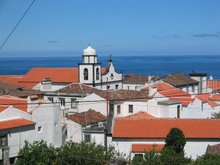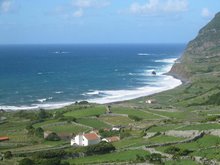... in the shops in Santa Cruz, I thought they must be crude representations of rowing boats or badly designed ashtrays. Or perhaps badly designed ashtrays in the form of crude representations of rowing boats but, whichever, they must have had some vital function to judge from the volume of them on sale.
Little did I realise they are in fact assadores do choriço which translates as "sausage griller" (choriço being the generic Portuguese word for a sausage and not necessarily what we Brits would characterise as a chorizo: every chorizo is a choriço but not every choriço is a chorizo, if that helps. That's a syllogism. Or is it a Venn Diagram? And what's a salsiche? I digress.)
A top tip for the operation of assadores de choriço to avoid dripping molten nylon is not to place them directly under Balinese boat kites suspended from your kitchen ceiling:-
Once the alcohol has burnt off (and your Balinese boat kite has decayed to a glutinous blob - only joking), the choriço is done and looks like this:-
I used to make the mistake of attempting to eat linguiça like a British sausage, i.e. cutting in slices and eating whole. Doing that with linguiça involves chomping through the fat and is quite revolting. Instead, the trick (for me anyway) is to cut the skin open and eat the meat and leave the fat - approached that way, linguiça is one of the tastiest things on this planet. It's rich though - I can't manage much more than about 8 inches at a time (as the actress memorably remarked to the bishop).








3 comments:
LOL. That was funny, except for the kite.Well Neil the correct term is chouriço - a kind of sausage made with meat and paprika (colorau), fat,and it can be find everywhere at the supermarkets, etc. Now, linguiça,althought you can find it some in the markets for sale, is something veeeeery different and tasty, it's like a chouriço but it's home made and gets several days in 'vinha- d'allhos (wine, garlic and another spices)than goes to the fumeiro by the cheminee to get the aroma. Salsichas are made like ham (more or less)it's a B or C class product, if i make myself clear. The linguiças around the islands vary a lot. I must say that the one from Pico and Graciosa are the best. In Flores they put the seed os Cominhos, and i persinaly don't like it very much. there's the morcela wich is a blood sausage. In the mainland there are much more 'enchidos', actually i think they put the whole pig inside sausages, ehehe.
I remember seeing your sausage griller in the souvenir shop that you took us to in Flores (well that is how we think of your Ironmongers, and the fish scaler and lasagne dish we bought are so much more evocative than a ceramic windmill or a snowglobe). How nice to know that it has a purpose.
As you say, the choriço is "not really a sausage as we Brits would understand it, it's more chunks of meat and fat stuffed into a sausage skin". Perhaps it should be made clear that a sausage as we Brits do understand it contains a little fat to the extent that it can be found amongst the sweepings from the abattoir floor, but it certainly contains no meat. Those swweepings, some E numbers, piles of sawdust and a little pepper, that is all you need for the great British banger.
D
PS I am excited to find you have found another use for the local cooking alcohol.
Neil you should go to the www.picodavigia.blogs.iol.pt, to find beutiful stories about local costumes of Fajã-Grande, including the art of making linguiça.
Post a Comment